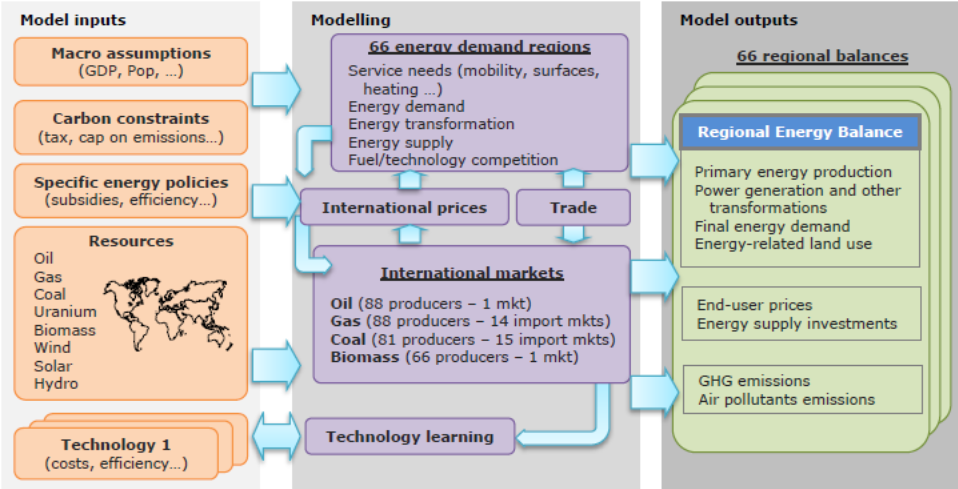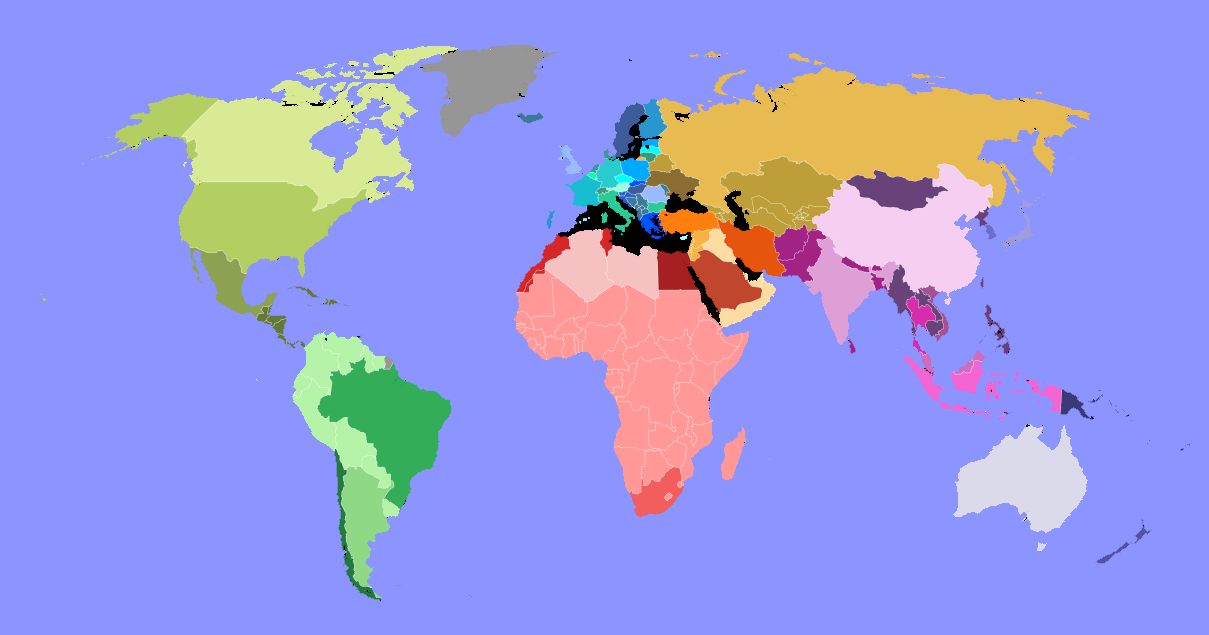The POLES model
Short overview
The Prospetive outlook on energy systems (POLES) is a partial equilibrium model that represents detailed world energy system dynamics. It explores the interactions between the energy systems and climate. The role of POLES is put incoherence detailed informations from the supply, transformation and use of energy to provide scientific insights onthe world and detailed country level of energy decarbonsation pathways. The model components provide a faithful representation of the best current scientific understanding of underlying behaviour.
POLES allows users to explore what-if scenarios, quantifying the implications of possible future conditions. These outputs are not predictions of the future; they are a way of analysing the potential impacts of different assumptions about future conditions. POLES reads in external “scenario assumptions” about key drivers (e.g., population, economic activity, technology, and policies) and then assesses the implications of these assumptions on key scientific or decision-relevant outcomes (e.g., commodity prices, energy use and emissions).
POLES has been used to produce scenarios for national and international assessments in the two last IPCC scenarios (sources).
Key features of the POLES model
POLES takes in a set of assumptions and then processes those assumptions to create a full scenario of prices, energy and other transformations, and commodity and other flows across regions and into the future. The energy, economy and climate systems are interconnected and interact with each other (see the figure below). The interactions between these different modules are modelled as one integrated whole.

Geographic coverage
The POLES core represents the entire world, but it is constructed with different levels of resolution for each of these different systems. The energy-economy system operates at 66 geopolitical regions globally , 88 oil producers, gas producers, coal producers

The structure of the energy system consists of four main elements: resource production, energy transformation, final energy consumption and end-use (see the figure below). It also tracks international trade in energy commodities. All the different elements of POLES interact through market prices and physical flows.
Climate module & emissions granularity
Emissions pathways by scenario exogenous
Socioeconomic dimensions
Economic growth
Population and economic activity are determined exogenously.
Industrial sector growth
Industrial sector growth Growth is based on a pre-defined GDP elasticity which decreases over time, thus assuming saturation of industrial demand with rising incomes. The values of these elasticities vary per region and between different SSPs. Apart from a GDP elasticity, industrial demand also depends on an assumed price elasticity for industrial energy use.
Transport sector growth
Per capita demand for passenger transport depends on an assumed GDP per capita elasticity and price elasticity, which means that more transport services are demanded at higher incomes and cheaper transport. However, there is also a time cost involved in transport, which increases proportionally with GDP per capita, and which is summed to the capital and energy costs of transport. This means that, at higher incomes, demand for passenger transport slowly saturates due to the price elasticity multiplied by the increasing costs of time. Also, demand shifts to faster ways of transport, for which time costs are lower. Demand for freight transport, like for industrial sectors, depends on an assumed GDP elasticity and price elasticity.
Building sector growth
Demand for energy services in residential and commercial buildings is primarily by total building floor space, which is driven by GDP per capita, and saturates at a given maximum value, defined per region. Per unit of floor space, demand for energy services increases over time depending on the relative price of the service, and the difference between the base year saturation and the defined maximum saturation for a certain service. For heating and cooling services, the maximum saturation depends on regionally explicit heating and cooling degree days.
Mitigation/adaptation measures and technologies
POLES is a technology-rich model that represents most major fossil fuel and low-carbon technologies that are envisaged to be available for at least the first half of the 21st century. By simulating the substitution of low-carbon for high-carbon technologies in response to their relative costs, as well as emissions constraints and/or carbon prices, the POLES model simulates mitigation through a large set of different measures. Also, certain assumption sets can be loaded from climate models for heating and cooling degree days, which are consistent with a certain temperature target. Through these assumptions, the model adapts to the simulated reality through the allocation of building service demands.
Economic rationale and model solution
The representative agents in the modules use information on prices and make decisions about the allocation of resources. They represent, for example, regional electricity producers or regional energy demand sectors who have to allocate generation by technology or energy demand mix. Markets are the means by which international prices are result of confrontation of demand and supply for oil, gas, coal, biomass or uranium. In other words, market equilibrium is assumed to take place in each one of these markets (partial equilibrium), and not in the entire economy across all markets (general equilibrium). The POLES solution process is the process of recursive iterating on market prices until this equilibrium is reached.
As an example, POLES derives a demand for natural gas starting with all of the uses to which natural gas might be put, such as power generation, hydrogen production, heating, cooling and cooking, other industrial energy uses or passenger and freight transport. POLES then calculates the amount of natural gas that suppliers would like to supply given their reserves and the market price.
POLES is a dynamic recursive model, meaning that decision-makers do not know the future when making a decision today. The POLES version used is typically operated in year by year-year time steps up to 2100 as the final simulation year.
Key parameters
Key scenario assumptions for the POLES model include socioeconomics (population, GDP); energy technology characteristics (e.g. costs, performance, water requirements); energy and other resources, such as fossil fuels, wind, solar, uranium; and policies, including emissions constraints, renewable portfolio standards, etc.
Key scenario results (outputs) from the POLES model include an analysis of the energy system (energy demands, flows, technology deployments, and prices throughout); prices and supplies of all agricultural and forest products, land use and land use change; water demands and supplies for all agricultural, energy, and household uses; and emissions for greenhouse gases and pollutents.
Parameters can be revised and updated in the framework of this project, following the feedback of local experts (stakeholder engagement), the comparative assessment with other modelling experiences, and the discussion with the partners (modellers).
Policy questions and SDGs
Key policies that can be addressed
POLES can be used to explore the implications of different future policies like :
Emissions-related policies
There are three main policy approaches that can be applied in POLES to reduce emissions of CO2 or other GHGs: carbon/GHG prices, emissions constraints, or climate constraints. In all cases, GCAM implements the policy approach by placing a price on emissions. This price then filters down through all systems in GCAM and alters production and demand. For example, a price on carbon would put a cost on emitting fossil fuels. This cost would then influence the cost of producing electricity from fossil-fired power plants that emit CO2, which would then influence their relative cost compared to other electricity generating technologies and increase the price of electricity. The increased price of electricity would then make its way to consumers that use electricity, decreasing its competitiveness relative to other fuels and leading to a decrease in electricity demand.
Carbon or GHG prices: POLES users can directly specify the price of carbon or GHG emissions. Given a carbon price, the resulting emissions will vary depending on other scenario drivers, such as population, GDP, resources, and technology. Emissions constraints: POLES users can specify the total amount of (CO2 or other GHG) emissions as well. POLES will then calculate the price of carbon needed to reach the constraint in each period of the constraint. Climate constraints: POLES users can specify a climate variable (e.g. concentration or radiative forcing) target for a particular year. Users determine whether that target can be exceeded prior to the target year.
Energy production policies
POLES can explore the implications of a constraint on production or a minimum production requirement which allows POLES users to model policies such as renewable portfolio standards and biofuels standards. Across sectors, these constraints must be applied as quantity constraints, but they can be applied as share constraints within individual sectors (e.g. fraction of electricity that comes from solar power). In implementing these policies, users can set either a lower bound or an upper bound. The model will solve for the tax (upper bound) or subsidy (lower bound) required to reach the given constraint.
Implications for other SDGs
POLES does not automatically calculate the implications on non-climate SDGs of its least-cost energy system to meet prescribed climate or emissions constraints. However, it is possible to use its outputs and calculate the predictions for certain indicators framed in the SDG agenda.
Recent use cases
| Paper DOI | Paper Title | Key findings |
|---|---|---|
| https://doi.org/10.1016/j.jhydrol.2019.04.046 | Global agricultural green and blue water consumption under future climate and land use changes | Global crop green water consumption will increase by 12% in 2090s when compared with that in 1971–2000, and climate change will dominate over land use change in determining the trend of global crop green water consumption. However, expansion in global irrigated area will dominate the changing trend of global crop blue water consumption which increases 70% by 2090s, especially in regions with significant irrigated land expansion (e.g. northern Africa, central Asia, China, Mexico, the Middle East, Russia, southern Asia, and Argentina). Furthermore, global crop blue water dependence will increase under climate and land use changes, especially in arid regions. |
| https://doi.org/10.1016/S2542-5196(18)30029-9 | Health co-benefits from air pollution and mitigation costs of the Paris Agreement | The health co-benefits substantially outweighed the policy cost of achieving the 2°C target. The ratio of health co-benefit to mitigation cost ranged from 1.4 to 2.45, depending on the scenario. At the regional level, the costs of reducing GHG emissions could be compensated with the health co-benefits alone for China and India, whereas the proportion the co-benefits covered varied but could be substantial in the European Union (7–84%) and USA (10–41%), respectively. Finally, we found that the extra effort of trying to pursue the 1.5°C target instead of the 2°C target would generate a substantial net benefit in India (US$3.28–8.4 trillion) and China ($0.27–2.31 trillion). |
| 10.1126/science.aad5761 | Can Paris pledges avert severe climate change? | To limit warming to any level, CO2 emissions at the global level must ultimately be brought to zero. If emissions are not brought swiftly to zero beyond 2100, the chances of extreme temperature change after 2100 could be much higher and the chance of limiting warming to 2°C much lower. The Paris scenarios reduce probabilities of extreme warming and increase the probability of limiting global warming to 2°C this century. |
References
Stéphane Allard, Silvana Mima, Vincent Debusschere, Tuan Tran Quoc, Patrick Criqui, et al.. European transmission grid expansion as a flexibility option in a scenario of large scale variable renewable energies integration.
Energy Economics, Elsevier, 2020, pp.104733. ⟨10.1016/j.eneco.2020.104733⟩ .
Mantulet, Gabin, Bidaud, Adrien and Mima, Silvana. 2019. "The role of biomass gasification and methanisation in the decarbonisation strategies." Energy:Available online 16 December 2019, 116737, pp. 1-19.
Luderer, G., Pehl, M., Arvesen, A. et al. Environmental co-benefits and adverse side-effects of alternative power sector decarbonization strategies. Nat Commun 10, 5229 (2019) doi:10.1038/s41467-019-13067-8 Applied Energy 240 (2019) 964–985
Katerina Kermeli, OreaneY. Edelenbosch, Wina Crijns-Graus, BasJ.vanRuijven, Silvana Mima, Detlef P.vanVuuren, Ernst Worrell
The scope for better industry representationin long-term energy models: Modeling the cement industry. journal homepage: www.elsevier.com/locate/apenergy

